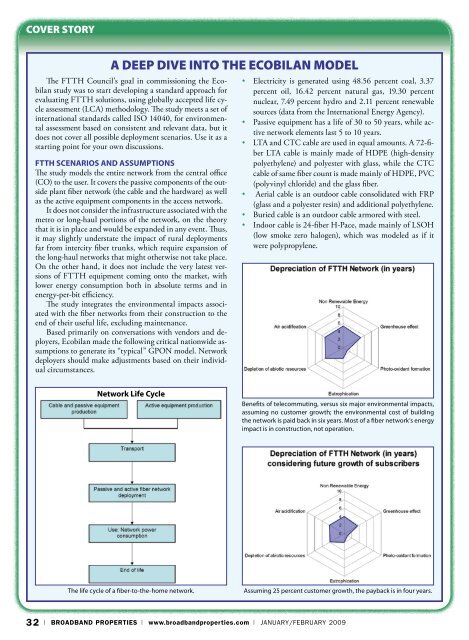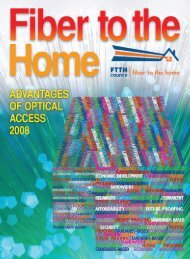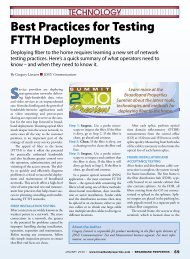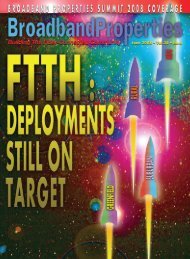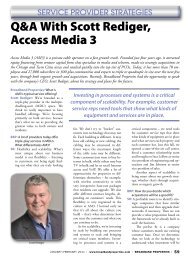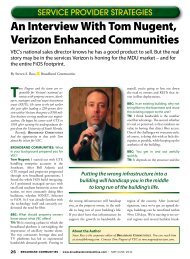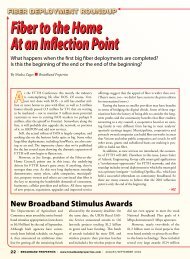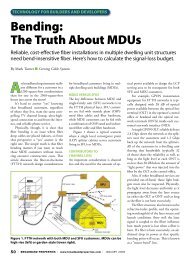bbpmag.com - Broadband Properties
bbpmag.com - Broadband Properties
bbpmag.com - Broadband Properties
Create successful ePaper yourself
Turn your PDF publications into a flip-book with our unique Google optimized e-Paper software.
Cover Story<br />
A Deep Dive Into the Ecobilan Model<br />
The FTTH Council’s goal in <strong>com</strong>missioning the Ecobilan<br />
study was to start developing a standard approach for<br />
evaluating FTTH solutions, using globally accepted life cycle<br />
assessment (LCA) methodology. The study meets a set of<br />
international standards called ISO 14040, for environmental<br />
assessment based on consistent and relevant data, but it<br />
does not cover all possible deployment scenarios. Use it as a<br />
starting point for your own discussions.<br />
FTTH Scenarios and Assumptions<br />
The study models the entire network from the central office<br />
(CO) to the user. It covers the passive <strong>com</strong>ponents of the outside<br />
plant fiber network (the cable and the hardware) as well<br />
as the active equipment <strong>com</strong>ponents in the access network.<br />
It does not consider the infrastructure associated with the<br />
metro or long-haul portions of the network, on the theory<br />
that it is in place and would be expanded in any event. Thus,<br />
it may slightly understate the impact of rural deployments<br />
far from intercity fiber trunks, which require expansion of<br />
the long-haul networks that might otherwise not take place.<br />
On the other hand, it does not include the very latest versions<br />
of FTTH equipment <strong>com</strong>ing onto the market, with<br />
lower energy consumption both in absolute terms and in<br />
energy-per-bit efficiency.<br />
The study integrates the environmental impacts associated<br />
with the fiber networks from their construction to the<br />
end of their useful life, excluding maintenance.<br />
Based primarily on conversations with vendors and deployers,<br />
Ecobilan made the following critical nationwide assumptions<br />
to generate its “typical” GPON model. Network<br />
deployers should make adjustments based on their individual<br />
circumstances.<br />
• Electricity is generated using 48.56 percent coal, 3.37<br />
percent oil, 16.42 percent natural gas, 19.30 percent<br />
nuclear, 7.49 percent hydro and 2.11 percent renewable<br />
sources (data from the International Energy Agency).<br />
• Passive equipment has a life of 30 to 50 years, while active<br />
network elements last 5 to 10 years.<br />
• LTA and CTC cable are used in equal amounts. A 72-fiber<br />
LTA cable is mainly made of HDPE (high-density<br />
polyethylene) and polyester with glass, while the CTC<br />
cable of same fiber count is made mainly of HDPE, PVC<br />
(polyvinyl chloride) and the glass fiber.<br />
• Aerial cable is an outdoor cable consolidated with FRP<br />
(glass and a polyester resin) and additional polyethylene.<br />
• Buried cable is an outdoor cable armored with steel.<br />
• Indoor cable is 24-fiber H-Pace, made mainly of LSOH<br />
(low smoke zero halogen), which was modeled as if it<br />
were polypropylene.<br />
Network Life Cycle<br />
Benefits of tele<strong>com</strong>muting, versus six major environmental impacts,<br />
assuming no customer growth; the environmental cost of building<br />
the network is paid back in six years. Most of a fiber network’s energy<br />
impact is in construction, not operation.<br />
The life cycle of a fiber-to-the-home network.<br />
Assuming 25 percent customer growth, the payback is in four years.<br />
32 | BROADBAND PROPERTIES | www.broadbandproperties.<strong>com</strong> | January/February 2009


